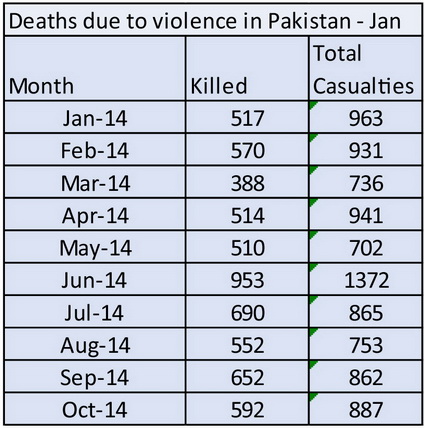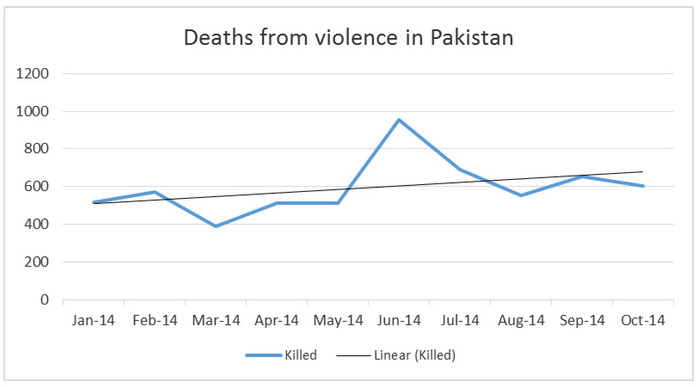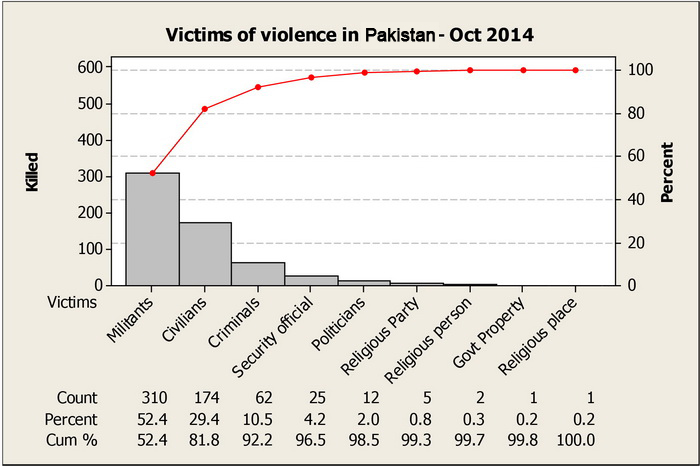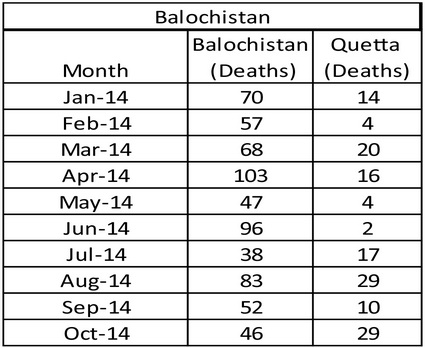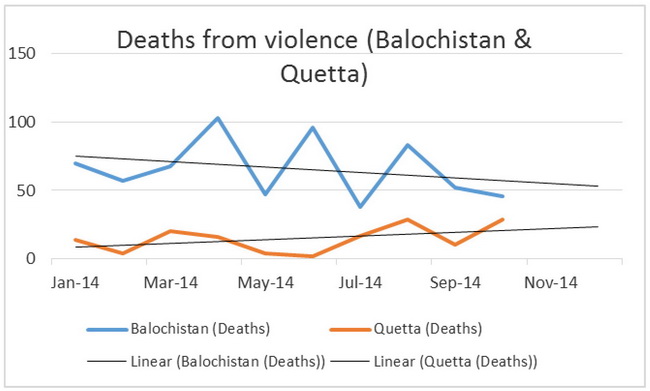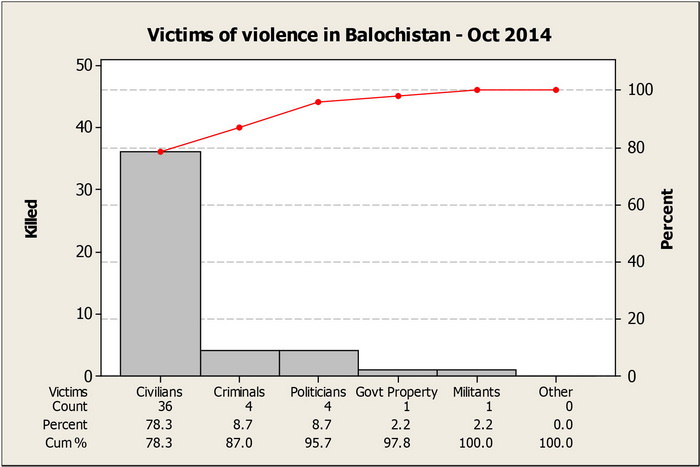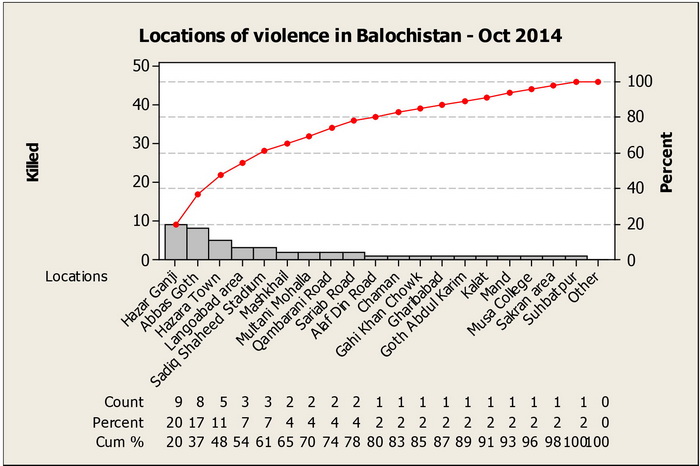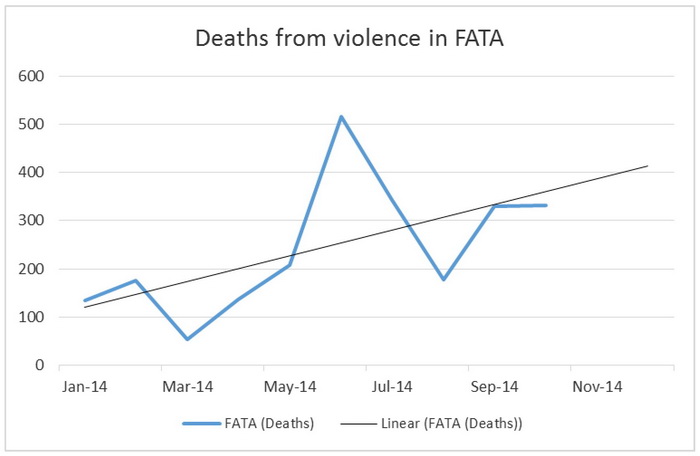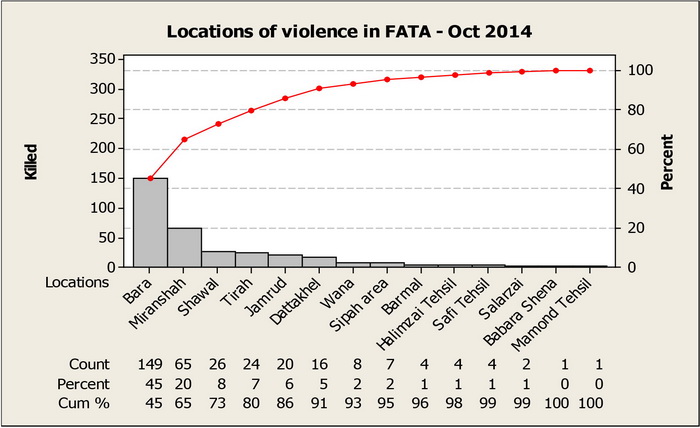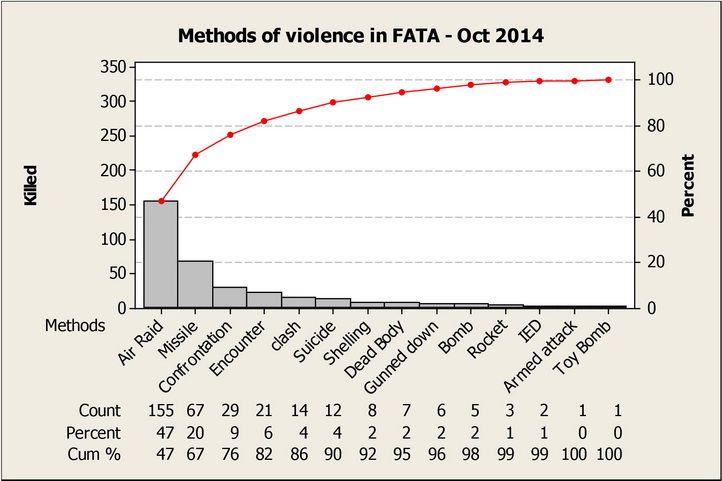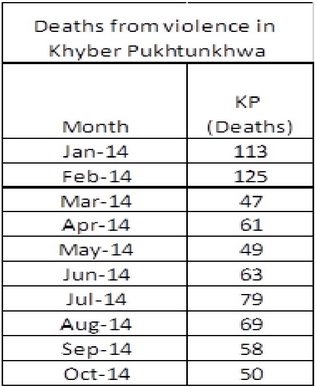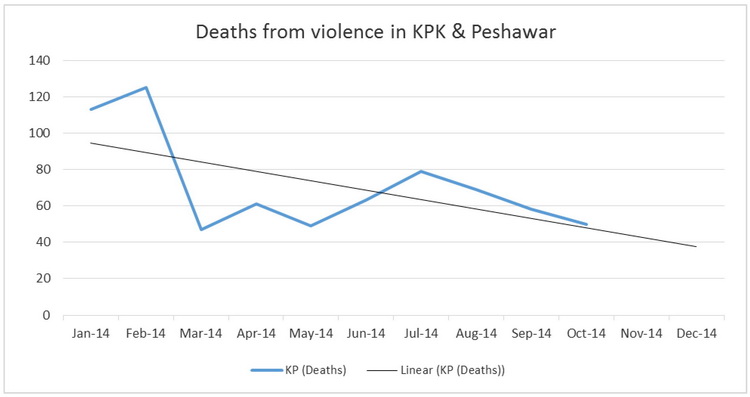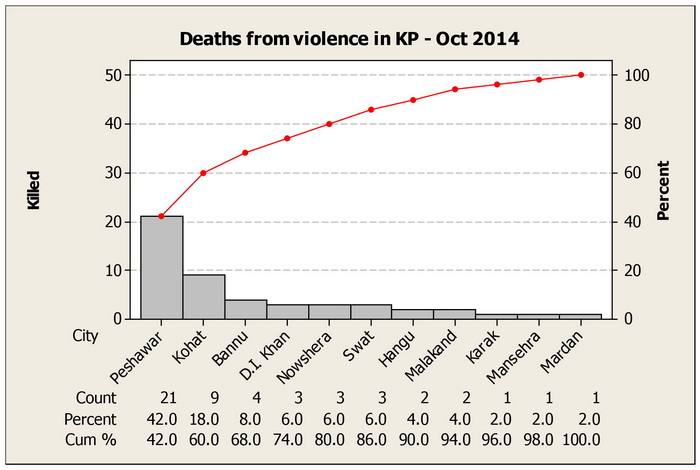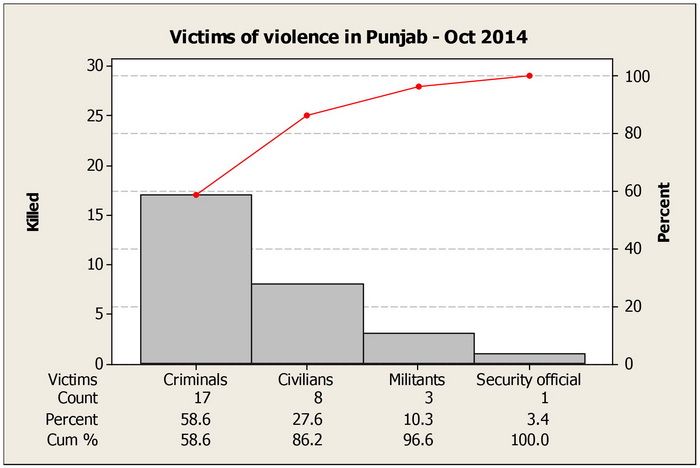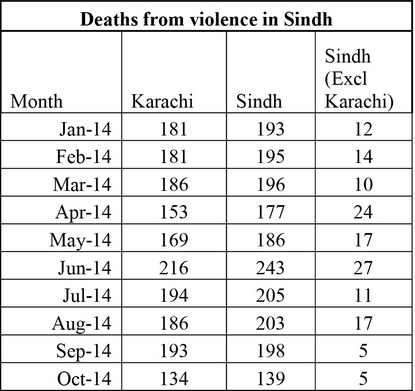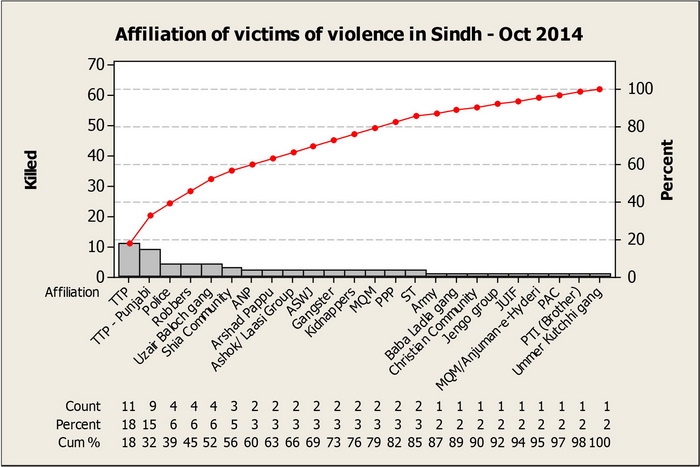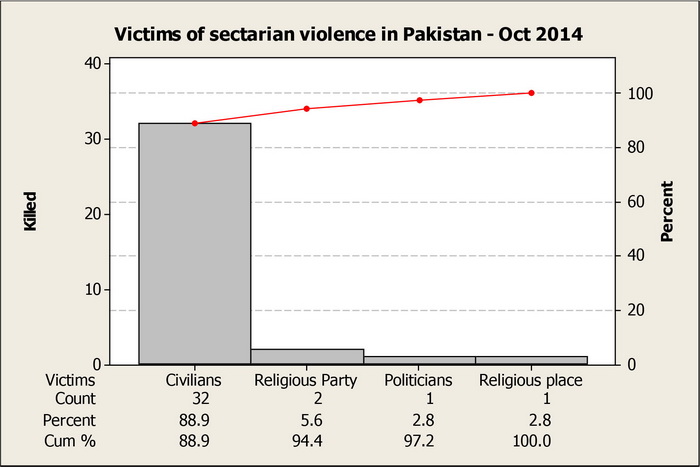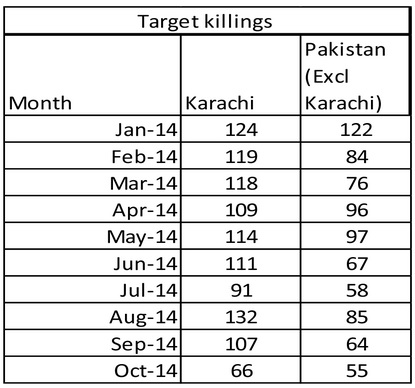This report is an attempt to analyze the overall law and order situation in the country and look at the challenges that keep emerging from the acts of violence by various criminal and political non-state actors following topics are selected to have a comprehensive coverage of the subject being discussed:
Casualties of violence in the country during October 2014
Casualties of violence in Balochistan
Casualties of violence in FATA
Casualties of violence in Khyber Pakhtunkhwa (KP)
Casualties of violence in Punjab
Casualties of violence in Sindh
Sectarian violence in Pakistan
This report is based on open source information, largely reports as they appeared in national newspapers including (The News, Express Tribune, Dawn, Daily Times, and the Frontier Post) during the month of October. All efforts are taken to make this report as informative and factual as possible. Errors and omissions are always a possibility in such statistical work. However, such mistakes do not grossly affect the basic objectives and the ultimate analysis of this report.
CRSS will appreciate receiving comments that the readers may have on this report.
Report prepared by:
Mohammad Nafees
Senior Research Fellow
Center for Research and Security Studies
NOTE: Readers can approach CRSS for source of any information included in the report. Please send your request to: (mail@crss.pk or mohammad.nafees@yahoo.com)
OVERVIEW
Fatalities from violence in the country during October, 2014:
Deaths = 592
Injured = 295
The incidents of violence and counter-violence in the country left 592 persons dead and 295 wounded during the month of October 2014 (Refer table 1 and graph 1) with FATA having the highest number of fatalities followed by Sindh, KP, Balochistan, Punjab, AJK, and GB (Refer graph 2).
Table 1: Deaths from violence in provinces – October, 2014:
Graph 1: Deaths from violence in Pakistan – October, 2014:
Graph 2: Deaths from violence in provinces – October, 2014:
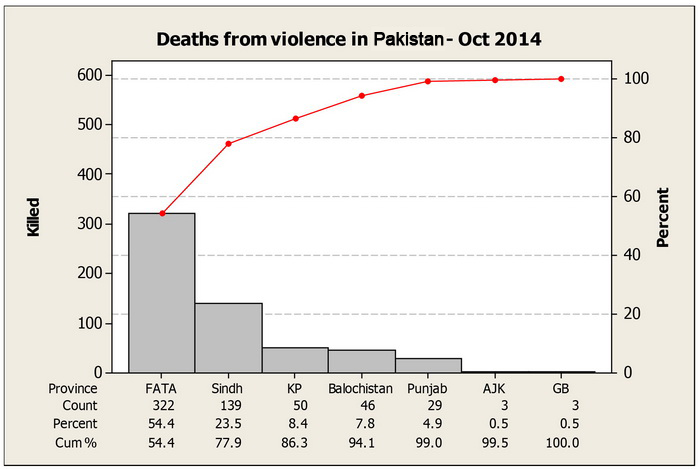
The number of fatalities from violence this month is down by nearly 10% compared to previous month and the majority of victims belong to the militants and criminals (over 60%) that were killed during military operation ‘Zarb-e-Azb’ in FATA regions of Waziristan and Khyber Agency and in encounters with the security forces (Refer graph 3). This trend is similar to what was observed in September, and an indicator that religious militants and criminals are constantly being dealt with sternly by the security forces. The resultant effects of this operation can also be witnessed from the reduction in number of fatalities of political activists, government and security officials, and religious persons (Refer table 2).
Graph 3: Victims of violence in Pakistan – October, 2014:
Table 2: Victims of violence in provinces – October, 2014:
A decline in fatalities from target killings, militants’ attacks, and security operation was also noticeable during this month while fatalities from drone attacks went up significantly (Refer table 3).
Table 3: Deaths from violence in Pakistan (Historical Data) – January – October 2014:
Unlike previous month, Khyber Agency lost more people than North Waziristan and Karachi. Quetta, Peshawar and South Waziristan were the next three districts where fatalities from violence were higher than all other districts (Refer Graph 4).
Graph 4: Deaths from violence in Pakistan – October, 2014:
Casualties of violence in Balochistan
Dead = 46
Wounded = 89
While the province of Balochistan experienced a slight decline in number of fatalities of violence during the month of October, the capital city of the province witnessed a sharp surge in number of fatalities (Refer table 4). Linear plotting of historical data shows that the graph of fatalities from violence in Balochistan is going downward while its capital city Quetta is showing an opposite trend (Refer graph 5). The other district with higher number of fatalities in Balochistan was Lasbella where nine laborers were killed on the basis of their ethnicity (Refer graph 6). Another important point to note is that the ratio of fatalities of militants and criminals is hardly 10% while fatalities of civilians, political activists, and government/security officials are 90% (Refer graph 7).
Table 4: Deaths from violence in Balochistan & Quetta – Oct 2014:
Graph 5: Deaths from violence in Balochistan & Quetta – Oct 2014:
Graph 6: Deaths from violence in Balochistan (District wise) – Oct 2014
Graph 7: Victims of violence in Balochistan – Oct 2014
The locations that remained highly affected of violence during the month of October were Hazar Ganji, Abbas Goth, Hazara Town, Langhoabad, Sadiq Shaheed Stadium, and others (Refer graph 8).
Graph 8: Victims of violence in Balochistan (Locations) – Oct 2014
Militants’ attacks and target killings were the most common forms of violence that were cause of death to 90% of the total number of people who died in Balochistan during the month of October. United Baloch Front (UBF) and Jundullah were the two groups that claimed to have killed seven persons.
Casualties of violence in FATA
Dead = 322
Wounded = 94
The military operation, drone attacks, and the retaliatory acts of violence by the militants continued unabatedly in FATA region leaving 278 militants and 29 civilians and 14 security personnel dead. The Linear Plotting of the number of fatalities in FATA (Refer table 5 and graph 9) shows a sharp inclining trend in violence in the region. One of the major contributors to this sharp rise in number of fatalities is the ongoing military operation in the region. Khyber agency had the highest number of fatalities (190) besides North Waziristan (108), South Waziristan (12), seven in Mohmand, four in Bajaur and one in Orakzai. The areas within these agencies that remained highly affected of violence were Bara Tehsil, Miranshah, Shawal area, Tirah Valley, Jamrud, Dattakhel and many others (Refer graph 10).
Table 5: Deaths from violence in FATA – Oct 2014:
Graph 9: Deaths from violence in FATA – Oct 2014
Graph 10: Deaths from violence in FATA (Locations) – Oct 2014
Nine incidents of air raids using the jet fighters and gunship helicopters by the armed forces during the month to target the hideouts of the militants in the North Waziristan and Khyber Agency are reported. Meanwhile eight incidents of bomb explosions by the militants causing deaths to civil population and destroying government installations are also reported. Whereas, Encounters, clashes and confrontations of security forces with the militants and three incidents of rocket attacks by the militants on security forces are also highlighted in the national dailies. There were several reports of IED and landmine explosions besides the reports of 130 militants belonging to Lashkar-e-Islami that surrendered to the security forces in Khyber Agency. The number of people died in these incidents of violence is reflected in the graph 11 below:
Graph 11: Methods of violence used in FATA – Oct 2014
Casualties of violence in KP
Dead = 50
Wounded = 34
Since January 2014, a constant downward trend in the number of fatalities from violence in Khyber Pukhtunkhwa can be noticed from the graph 6 and table 12 below. However, the ratio of fatalities of civilian and lawless elements is quite unproportionate. More than 80% of the total fatalities off violence in KP belong to civilians and security personnel. Peshawar, the capital city of the province, was highly affected of violence followed by Kohat, Bannu, D.I. Khan, Nowshera and others (Refer graph 13).
Table 6: Deaths from violence in KP – Oct 2014
Graph 12: Deaths from violence in KP – Oct 2014
Graph 13: Deaths from violence in KP (District wise) – Oct 2014
Sectarian violence in KP caused death to 13 persons belonging to Shia community and an attempt was made to blow up a Sufi shrine of Sheikh Abdul Qadoos in Pishtakhara, Peshawar. There were nine reports of kidnapping and dumping of dead bodies from different parts of the province, one of the deadbodies belonged to a policeman who was kidnapped a year ago. Another prominent case was of a father-in-law of the President of the Press Club of Peshawar whose dead body was dumped nearly a week after his kidnapping. The activists of ANP are still being targeted by the militants in KP and this month two party workers lost their lives in target killing.
Casualties of violence in Punjab
Dead = 29
Wounded = 0
Punjab lost 29 persons in violence during the month of October, 2014 and more than three fourth of them were criminals and militants while the civilians were less than one third (Refer graph 14). Among the 17criminals, 14 were robbers and the remaining three were car snatchers and offenders. Three militants associated with the Tehreek-e-Taliban of Pakistan were also killed in an encounter with the police in Ahmadpur East, Bahawalpur. Among the six civilian victims of violence, two were journalists belonging to Dunya TV and Express News who were killed in Hafizabad within a gap of two days. In a sectarian violence, a retired officer of Pakistan Air Force (PAF) belonging to Ahmadi community was killed in Attock. In Rahim Yar Khan, polio team was attacked by a school teacher and a revenue officer but no casualty took place.
Graph 14: Victims of violence in Punjab – Oct 2014
Casualties of violence in Sindh
Dead = 139
Injured = 78
Karachi:
Dead = 134
Wounded = 75
In Sindh, a significant decline in number of fatalities from violence was observed during the month of October. Only five persons out of 139 were killed in other parts of the province while the remaining 134 were slain in Karachi. However, this was the lowest number of fatalities during this year for Karachi (Refer table 7 and graph 15).
Table 7: Deaths from violence in Sindh & Karachi – Oct 2014
Graph 15: Deaths from violence in Sindh & Karachi – Oct 2014
Despite the ongoing Rangers’ operation in the metropolitical city of Karachi, the percentage of criminals and militants remained around 40% of the total number fatalities, meaning the percentage of civilians, security officials, political activists, religious party activists and others was more than the fatalities of lawless people (Refer graph 16). Lyari, Landhi, Malir, and Korangi areas of Karachi remained the highly affected areas of violence during the month under review (Refer graph 17). Target killing was the common method of violence in Karachi that left 66 persons dead.50 persons were killed in encounters with the Security Forces, while ten persons were killed by the robbers during their attempts of robbery.
Graph 16: Victims of violence in Sindh – Oct 2014
Graph 17: Deaths from violence in Sindh (Locations) – Oct 2014
Lynching incidents in Karachi:
Fierce retaliation of the people against criminals came to light this month in Karachi when ten suspected criminals were beaten to death at the different locations in the city. This was the highest number of lynching incidents in Karachi during this year.
Banned outfits and other militant groups operating in Karachi:
After FATA and KP, Karachi is the next place where all banned militant organizations have their presence. The data on affiliation of the victims of violence for the month of October shows that there were twenty militants belonging to TTP and TTP-Punjab that were killed in encounters with the security forces. Besides, there were people belonging to different gangs, political parties, religious parties, and security officials who lost their lives in different acts of violence in the city during the month of October (Refer graph 18).
Graph 18: Affiliation of victims of violence in Sindh – Oct 2014
Sectarian violence in Pakistan
Dead = 36
Injured = 64
The menace of sectarian violence is on the rise again. Last month, the casualties of sectarian violence were 33 (26 dead and 7 wounded) that shot up to 100 with 36 dead and 64 wounded. Balochistan was on top among all other provinces with a loss of 16 persons in Quetta, followed by 13 in KP , six in Sindh and one in Punjab. Although sectarian violence has its links with the religious beliefs, the victims of this violence like all other types of violence are civilians (Refer graph 18). Shia community continues to be the main target of sectarian violence. During the month of October, sectarian violence targeted 31 persons of Shia community, followed by four persons from Sunni community, and one person from Ahmadi community (Refer graph 19). The districts that remained highly affected of this violence were Quetta where 16 people lost their lives followed by seven in Peshawar, six in Kohat and one in Attock. Their locations are reflected in the graph 20. Bomb explosions, indiscriminate firings, , suicide attack, and hand grenade attacks were the methods used to carry out sectarian violence.
Graph 19: Victims of sectarian violence in Pakistan – Oct 2014
Graph 20: Religion of victims of sectarian violence in Pakistan – Oct 2014
Graph 21: Locations of sectarian violence in Pakistan – Oct 2014
Conclusion:
Significant drop in number of fatalities of civilians and security personnel compared to the fatalities of militants and criminals was noticeable during the month of October. Yet, militancy continued taking its tolls by shifting its locations and target of operations. Unlike last two months, the suicide attacks re-emerged this month and reported three incidents, one of them targeted a religious community, the second attack targeted a Peace Lashkar Jirga and the third attack targeted Maulana Fazlur Rehman (leader of JUI-F), who luckily remained safe.
Target killing incidents are on the declining trend in the country and Karachi as well (Refer table 8 and graph 21). The ongoing operation can be cited as one of the major factors for such an improvement in crime control.
Table 8: Deaths from target killings in Pakistan & Karachi – Jan – Oct 2014
Graph 22: Locations of sectarian violence in Pakistan – Oct 2014
Sectarian violence needs to be brought under control. More than 300 persons have lost their lives to this form of violence during this year and after a slight decline during last two months a sudden upsurge was observed during the month of October.
Mob justice or lynching has suddenly emerged as a fierce retaliation of the people against the unabated incidents of robberies and other street crimes especially in Karachi. Since July to October 2014, 14 robbers have been beaten to death and four have been injured. All these incidents took place in Karachi with the exception of one that was occurred in Hyderabad where a robber was injured by the mob.


